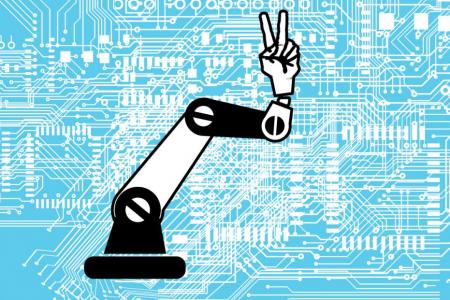Rise of robots means better future for human beings
Automation means more time will be freed up for humans to take on higher-value work
"What do you want to be when you grow up?"
We often ask children that, without expecting them to know.
How could they? Especially in today's context, when 65 per cent of children entering primary school are likely to end up in a job that does not exist yet, according to a World Economic Forum report.
Advances in technology have transformed the job landscape, and none more so than the breakthroughs in automation - or rise of robots, as some call it.
As far back as 2013, an Oxford study already concluded that almost one in every two jobs has a high risk of being automated.
A separate Infosys survey earlier this year showed four out of 10 youths believe machines will be able to do their jobs within a decade.
The truth, as always, is somewhere in between.
Yes, 45 per cent of activities people are paid to do could be automated with today's technology, according to an analysis by the McKinsey Global Institute. But fewer than 5 per cent of occupations can be fully automated. Man remains essential.
What automation means is that more time will be freed up for us to take on higher value work. Consider these likely possibilities for design and engineering jobs in 2020.
ROBOT TRAINER
Robots are great for precise, repetitive work but not so great for creative, expressive work.
The chef who understands flavour combinations and how to create an inventive meal is not going away anytime soon, but menial tasks such as chopping onions and carrots may be better handled by a robot.
Robots are only now becoming capable of doing this task. Every vegetable presents variations in size, weight and shape, which robots are adjusting to with the help of artificial intelligence - or what we call machine learning.
Software is at the heart of robots, and as they take on more varied and nuanced jobs, the need for humans rises.
This paves the way for the creation of new jobs, such as robot trainers to demonstrate complex tasks for robots to learn and perform. Even in the manufacturing space where robots are widely deployed, we see a growing need worldwide for skilled manpower to operate them.
This is also likely to be the case here as the Government looks to scale up the use of robots among manufacturing SMEs, as part of the Industry Transformation Programme announced in the 2016 Budget.
GENERATIVE DESIGNER
The cloud has given us infinite computing capabilities. For instance, in the design field, software that can generate up to thousands of designs for a single product based on criteria - such as weight, strength, cost, size, materials - is emerging.
We call this generative design. For example, Autodesk worked with Airbus to build a lighter, stronger and more environmentally compatible aircraft. Using a combination of machine learning, 3D printing and generative design technology, Airbus has produced an aircraft cabin component, a bionic partition, 45 per cent lighter than current designs.
If applied to the entire cabin and the current backlog of A320 planes, this could save up to 465,000 tonnes of CO2 emissions a year by Airbus estimates.
This is the equivalent of taking about 96,000 passenger cars off the road for one year, feeding into global efforts to lower carbon emissions as part of the Paris Agreement.
A computer can assist a designer by providing thousands of design options.
The creative inputs of a human - this is, a generative designer - then come into play in defining the design parameters and setting the machine's learning objectives, in order to choose the option that best meets what the user is looking for.
This is similar to what data analytics specialists are doing today in finding insights from Big Data and converting Big Data into smart and usable data.
SENSOR SYSTEM INTEGRATOR
Also in time, sensors on machines and devices will be able to communicate with other sensors directly, and not through a medium such as a central computer or a smartphone app.
The fitness tracker today only senses and breaks down your level of activity. An evolved fitness tracker could also act on it and place an order for groceries with Redmart and Honestbee that will help in recovery when it senses you have completed a marathon. However, we need someone to set up this stage - a sensor system integrator, for lack of a better term. This job might not exist at the moment, but it will have to as associated technologies continue to mature.
BEYOND JOBS
Technology is advancing at a quick pace, cutting across a wider segment of industries, and effecting more transformations than ever. The possibilities presented by increased collaboration between machines and man go beyond jobs and economy. Together we can create solutions to problems that humans could never conceive. Already we are enjoying the results of these developments such as autonomous vehicles.
To venture further, we need to embrace the opportunities technological progress provides. Thankfully, with the rise of robots, we can soon afford the mind space to explore these possibilities and bring about a better future.
The writer is regional director of Asean at Autodesk. This article appeared in The Business Times yesterday.
Get The New Paper on your phone with the free TNP app. Download from the Apple App Store or Google Play Store now


